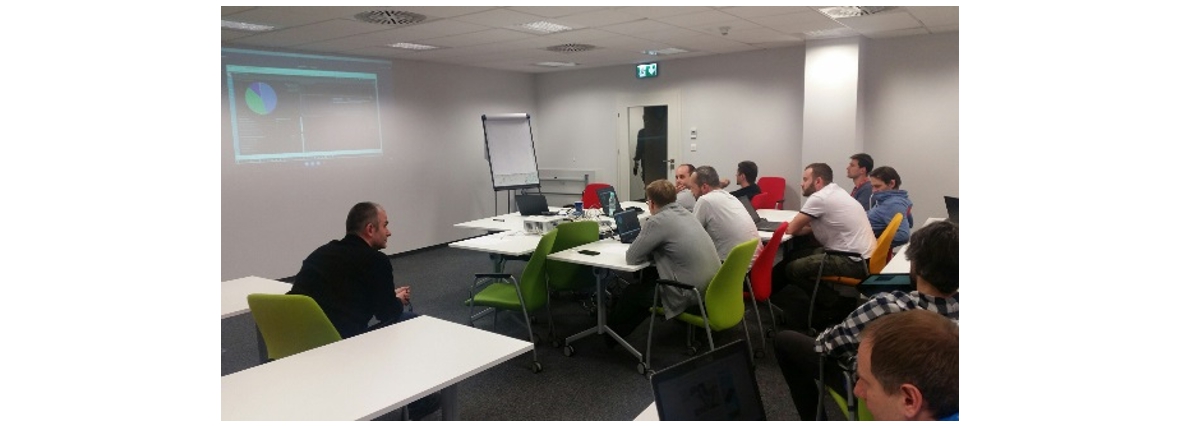As engineers at a global company with competition around every corner, we believe that continuous innovation is the key to competitive differentiation. But innovation is an elusive thing and doesn’t appear on demand. The popular image we have when we think of innovation is that of the lone engineer having a light-bulb moment. Sometimes it does happen that way, but true light-bulb moments are unpredictable and can be few and far between.
Our team has the concept of an innovation engine that’s always on and sitting at the center of our innovation ecosystem. There are many parts to this engine, and recently we added a new one: hackathons.
Hackathons have been part of the high-tech industry for a few years now, and tech companies are taking notice. A year ago, we decided to give it a try with one of our product development teams.
But first … what exactly is a hackathon?
Good Stuff Happening Quickly
A hackathon is an innovation event, where people (typically software engineers) come together to quickly prototype or “hack” some idea together. The idea is to explore and create something new, do it quickly, and have something cool to show at the end of the event. Hackathons usually last for 24 to 48 hours and it’s always amazing to see what engineers can produce in such a short time. It’s a little like being back in school, working to get that assignment in before the deadline. For software engineers, it’s an excuse to “geek out” a little and have fun with a bit of competitive coding. It’s creative, it’s challenging and we get to try things we normally wouldn’t think to attempt in a normal project.
Hacks developed in this way are rarely product-quality, but their real value is in the validation: we see abstract ideas and concepts take form before our eyes. Just like a picture can say more than a 1,000 words, a running hack makes a compelling argument compared to paragraphs on a page.
Let the Hacking Begin
We chose the 48-hour format for our events and they tend to go something like this:
Just prior to the hackathon, we announce the general theme and gather suggestions for ideas and challenges. Internal social media and wikis are great for organizing the effort without too much formality. We typically get 20-30 suggestions so there are a lot of problems for teams to choose from. Themes are broad but specific, such as “usability improvements”.

On the morning of the first day of the hackathon we all gather in a large room for the pitch sessions. Anyone can join, whether they are interested in hacking or just curious. Teams will come to the front one by one, present themselves and either suggest their own challenge, or pick one from the prepared list. Occasionally, someone in the crowd will suggest something on the spot. After each team has declared what they will work on, the hacking starts.
For almost two days the teams will work intensively to get the best hack ready. We keep refreshments on hand and bring in meals to make sure everyone is comfortable and can focus on having fun.

In the afternoon, on the second day we all gather back in the big room again for the hackathon wrap-up. It’s time to see the results! Each team will present their hack and show it running live. Here we accept only working code – and we’ve seen a lot of great things in these demos! More than once we’ve seen something prototyped in less than two days that would have taken weeks or months of debate.
After the demo sessions, everyone in the room gets to vote on the best hack, and we hand out small prizes for the top three. The biggest attraction is the bragging rights, though, valid for one year until the next hackathon.
So that’s a lot of fun, but what really makes our hackathons work so well is that we involve a lot more than just our software engineers. There’s a growing acceptance in high-tech that innovation is not just a function of IQ and lightbulbs, but rather what happens when new and unexpected connections are made. So we invite lots of people from outside of R&D, from customer-facing functions, to support, to infrastructure, to product line management and so on. The more people with different backgrounds we get, the better and more varied the ideas. And the more fun we have! When people from different backgrounds that don’t normally interact get to work together, the creative sparks really start to fly.
Results Time
So after two days of fun, what do we have to show for it?
It’s hard to put a price on increased motivation, improved communication and higher employee satisfaction, but it looks like two days of fun, competitive hacking goes a long way.
What about business value? In our first hackathon we had eight teams participating. Of the eight resulting hacks, six of the ideas have already been developed into full features and released in our products. One is under development right now and will be released this year. One hack was a proof-of-concept widget that will make its way into our GUI. We did not expect such a high success rate, and it just underscores how much untapped innovation is brewing across our company.
Going Forward
At ADVA Optical Networking, we’re now in our second year of hackathons and we’re expanding across the company to more R&D sites across the globe. It’s an annual event now, and as we get more R&D sites involved, we see more creativity and innovation grow from within. Admittedly, diverting a whole R&D site away from their day job for two full days seems difficult to do with aggressive deadlines. But, given the success we’ve achieved so far, the question isn’t “How can we afford to stop our projects for two days?” It’s “How can we afford not to?”
